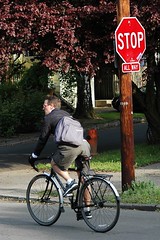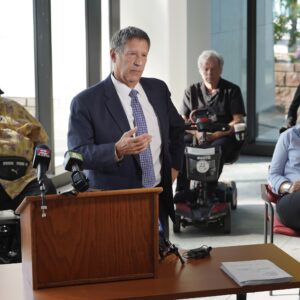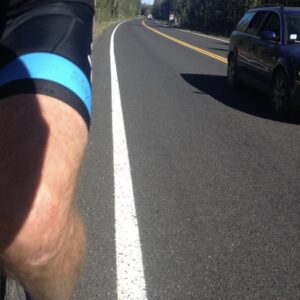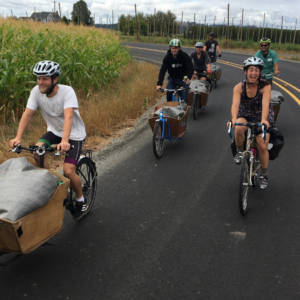The Bicycle Transportation Alliance (BTA), a Portland-based non-profit with over 5,000 members statewide, has proposed a new law that would make it legal to roll through a stop sign while riding a bicycle in Oregon.
In an interview this afternoon, BTA lobbyist Karl Rohde said the bill language is currently being drafted in Salem and it will be officially known as the “Idaho Stop Law”.
“We feel the law needs to change to reflect the safe behavior that’s happening now,” said Rohde, “Coming to a complete stop isn’t necessary for a vehicle (bicycle) that does not pose the same threat to other road users and whose operators have a greater awareness of their surroundings.”
- More info:
- Article on Idaho stop law by lawyer Ray Thomas
- A set of FAQs developed by the BTA
- A Q&A with Bjorn Warloe
In a set of frequently asked questions prepared by the BTA (I’ve posted them on Page Two and they’ll be published on the BTA’s Blog Thursday morning), they explain it like this:
This law would make it legal for bicyclists to treat stop signs like yield signs. A cyclist approaching an intersection controlled by a stop sign, would be permitted to roll through the stop sign after yielding the right of way if there are other vehicles at the intersection.
Rohde said the language of their bill will be very similar to an existing law in the state of Idaho which has been on the books since 1982 (and by most accounts, it has been implemented without incident and without negative impacts on traffic safety). A similar bill (HB 2768) was introduced in Oregon in 2003. It passed the House but did not make it through the Senate (read our analysis of the 2003 effort).
The Oregon legislature is full of new faces this session, and several of them are likely to be big supporters of the BTA’s Idaho Stop Law. Rohde says that newly elected state representative Jules Bailey (D-Portland) has already pledged his enthusiastic support. Other supporters are likely to include Floyd Prozanski (D-Lane County), Jackie Dingfelder (D-Portland), Jason Atkinson (R-Central Point) and others.
“…changing the law would eliminate the argument that cyclists are always breaking the law when they are actually acting in a very rational manner.”
— from an FAQ published by the BTA
The BTA’s Legislative Committee has researched this issue for several months. Noted lawyer Ray Thomas is on that committee and is an ardent supporter of the Idaho stop law concept. He published a lengthy article in November that refutes many concerns some people have about the law.
Another member of the BTA’s Legislative Committee that has pushed for this is Bjorn Warloe. You might remember Warloe as the citizen activist who spearheaded an attempt to push for the “Idaho Style” law back in 2007. Warloe received interest for his effort from State Senator Jason Atkinson, but it never progressed into becoming an actual bill.

BTA’s Legislative Committee.
The BTA’s proposal would apply to all stop signs in the state. There’s also a provision in the law that would allow cities to require bikes to come to a complete stop at certain intersections (cities would choose those on a case-by-case basis). In Idaho, the law has recently been extended to include stop lights as well, but that is not something the BTA will pursue at this time.
(According to Rohde, the BTA Board had concerns over the stop light portion of the proposal and he feels it has a better chance of being passed if it only applies to stop signs.)
Rohde says he’s optimistic that the proposal will become law. “Even for people that don’t bike and are not initially receptive this idea, once you explain it to them, they understand why it’s needed.” One tactic Rohde has found works well in explaining the proposal is to equate it to walking. “When you walk up to an intersection in a neighborhood and no one’s around,” he said, “you don’t come to a complete stop. You just look around and then go if it’s safe. We’re just applying that same logic to biking.”
For the BTA, passage of the Idaho Stop Law would accomplish many things, including:
- It would make biking easier and more efficient (having to stop unnecessarily is a “deterrant to many people”),
- it would put an end to the long and controversial legacy of Police enforcement actions (a.k.a. “stings”) at stop signs so they could “focus more of their limited resources on high-risk intersections”,
- it would “eliminate the argument that cyclists are always breaking the law when they are actually acting in a very rational manner.”
The BTA seems to have done their homework on this one. With their preparation and experience on this issue — along with the benefit of 27 years of successful implementation in Idaho and a legislature full of new, young lawmakers — 2009 might be the year Oregon finally goes “Idaho style”.
But even with many stars aligned, stop signs are one of those issues in the bike world (like helmets, fixed-gear bikes, licensing, and so on) that have potential to be controversial. How the media handles this could play an important role in its success (or failure). In 2003, many people think it was the media’s coverage of HB 2768 that ultimately led to its demise.
What do you think about this idea? Is it a no-brainer that will improve biking? Should the BTA just leave the law as-is? Is this a battle worth fighting? Let us know your thoughts.
— We have covered the Idaho stop law extensively. Browse our “Idaho Stop Law” tag for previous stories. In particular, we published guest pro/con editorials in February of 2007: David Dean wrote in support of changing stop sign laws for bikes and law student Rick Bernardi wrote in opposition to the idea. We have also just published an FAQ prepared by the BTA. The Idaho style stop law is also being proposed in Montana. Stay tuned for more coverage.
UPDATE: The BTA has published more on their reasons for pushing this law.







Thanks for reading.
BikePortland has served this community with independent community journalism since 2005. We rely on subscriptions from readers like you to survive. Your financial support is vital in keeping this valuable resource alive and well.
Please subscribe today to strengthen and expand our work.
Well, even as a Washingtonian, I’m quite exited. Too bad that they can’t include the part about stop lights, as there will always be some that just don’t work, even after calling them in. With the stop light law, I might also worry that now there would be no incentive for faulty detection loops to get fixed to sense bikes.
Keep up to good work, BTA!
I think one of the largest arguments will be that some imagine people of bikes blazing through stop signs. I like the prudent use of the word “roll” in this and other posts on the topic.
first of all I don’t believe that having to come to a stop at stop signs is a “detterant” to people riding bikes, but I do think this would be a good idea.
John,
an interesting note: the reason Idaho added the stop light provision was because they realized it would be much cheaper (as in free) to just let bikes roll through, than to go and retrofit all the streets with loop detectors that could sense bicycles (I’m not kidding, that is really why they did it.)
oops, I mean deterrant. anyway, I have a feeling this wouldn’t pass because people would be afraid bikers would abuse the definition of the word “yield”.
“first of all I don’t believe that having to come to a stop at stop signs is a “detterant” to people riding bikes, “
one reason the BTA wants this to pass is because n’hoods have fought to put many stop signs on their streets in order to deter and slow down car traffic… but unfortunately those are the same types of streets the City is increasingly wanting to use as bike routes… but the only thing keeping them from being great routes for bikes is that they’re full of stop signs.
according to the BTA, this law will hopefully maintain the traffic calming the n’hoods want, while making the streets more efficient and attractive for bike traffic.
oh yeah, I see what you mean. that makes sense, because it’s true, there are a lot of streets that I like to ride through that have a ton of stop signs, which I pretty much always do the “Idaho stop” with anyway.
Holy cats! I’ve had a burning desire to see this happen. I’ve felt that the burden was going to be on me to get this ball rolling! So happy that instead I can support the pros from the periphery!
The logic is so painfully obvious. Under current traffic law conditions, when cyclists and motorists meet at a 4-way stop, frequently everybody is confused. Most motorists half-way expect cyclists to roll through, regardless of who gets there first. Lack of law enforcement helps to maintain this state. Cyclists who DO want to stop often find themselves in a weird and sketchy stand-off with motorist who are afraid to proceed. Police are seemingly uncomfortable with busting (“harassing”) cyclists who roll through, regardless of how they roll through; therefore, the violators persist and confusion persists. Voting motorists continue to be fearful and angry.
I think this Idaho style could make it easier for police to bust any and all cyclist that might continue to make intersections confusing. Intersections would become safer. Under Idaho-style law, busting “yield” violators would probably NOT be perceived as “harassment”. I make this hopeful prediction because the new law would obviously support the needs of cyclists; therefore, breaking the new law might be universally identified as egregious. Intersections would become MUCH more predictable.
Now I must say that Portland seems to have the most lawful, respectful, and predictable cyclists around when compared to NY, SF, Seattle, etc – so intersections are not as bad as they could be. However, this kind of legislation would make them so much better and would create stronger precedent to encourage other cities to follow suit…
A promotion of efficiency AND safety that could net cyclists more respect and more ease. I love you, BTA. Godspeed.
I am all about this!
I must say that even being a big advocate for bikes, I have mixed feelings about this. I roll through stop signs quite often, but always while slowing and looking both ways twice (and even then I occasionally have to stop short for a car or person).
I’ve seen bicyclists go through intersections without looking carefully even without this law and I’ve seen pedestrians have to get out of the way.
From news on this site, it appears that Idaho stops are working fine across the border. Is that possibly because it’s more suburban and fewer people walk? Or do cyclists slow and use caution?
What do you all think?
#9
I think in part it is because the law makes sense and so people are more likely to follow it, while the police can spend their time enforcing only dangerous maneuvers. It is still under this proposed law entirely illegal to ride at a high rate of speed through an intersection, or to fail to yield to another vehicle or a pedestrian who has the right of way. No one is advocating unsafe riding, rather we are advocating a change in the law to permit cyclists to slowly and cautiously transit through empty intersections without coming to a complete stop.
Most cyclists have a pretty keen sense of self preservation, and while the occasional scofflaw may still exist under the new law Police resources will be freed up to focus on those few rather than on the majority of cyclists whose behavior is safe.
As you point out it is working very well in Idaho. I’ve talked to Idaho State Troopers, Boise Police, members of a Boise bicycling club, employees of the Idaho Department of Transportation, as well as Senators and Representatives and they all agreed that the law is safe and successful.
Go IDAHO!
This makes no sense. Changing the law to match currently illegal behavior? What’s next? Is stopping that difficult?
My over/under for # of comments to this story: 150. Place your bets, folks!
ummmm Afro Biker?
you sound like an prohibitionist during the days when it was illegal to consume alcohol. Just because the current law prohibits it does not mean the current law makes sense. Have you not read the logical arguments on this subject?
I use that method quite a bit, careful with
on coming traffic it seems a larger object
likes to try and beat you across, yeah im racing cars,, NOT.. anyway, it becomes a rat race somedays..
I – D – A – H – O,
Idaho,
Idaho,
GO, GO, GO!!
a.O? what’s that I hear? Is there a fellow Vandal in the midst? I had that in my head, but just sufficed with a simple “GO IDAHO!”
If you are an amputee cyclist the Idaho Law makes a lot of sense. Current law if followed mens that everytime an amputee comes to a stop sign, they have to stop, which means taking the artificial foot out of the toe strap so the foot can touch the ground. Starting back up the amputee has to reach down and put the artificial foot back on the peddle and into the toe strap. This requires looking at what you are doing so your eyes are not on the road. Makes a lot of sense!!!!. for this reason, most of my encounters with stop signs involve Idaho Stops.
BTA should take the opportunity to at least put in a provision that says if there is a loop detector and it is not sufficiently sensitive to detect your bike, you can treat it as broken and treat the light as a stop sign with cross traffic dominant. also would not be a bad idea to include in each of these legislative initiatives a push to get rid of the mandatory sidepath law that says you have to use a striped lane whenever it is provided . . .
its gonna be a nightmare unless the BTA would like to also mandate comprehensive, state wide, mandatory driver re-education …the majority of cyclists I see in this town are already running stop signs….tell them they have a law to do it now and some will increase their speed just as drivers do on freeways when speed limits are increased or eliminated (e.g. Montana in the late ’90s)…no increased prevalence of highway accidents then, but more and more of them had deadly outcomes.
I agree that there are a BIG surplus of pointless stop signs in some neighborhoods…but wouldn’t a more prudent solution be to remove stop signs, not change the laws so a special interest group can have it “their way” so they can save about 60 seconds on their commute to work or whatever?
I’m all for large speed bumps…slows down traffic in neighborhoods….doesn’t stop cyclists.
funny how everyone here has their own personal reason how/why they run stop signs….reads like a justification laundry list…but has anyone here stopped to notice that Oregon is NOT Idaho…in no way, shape, or form? Population densities are different….mentalities are different…
infrastructure is different.
Speed bumps seem to have mixed results where I live… lots of scraping sounds as car bumpers hit the pavement. I agree with bahueh on the likelihood of some riders abusing the law. Portland is definitely NOT like cities in Idaho…
I’m still holding out on my Bud Clark donation until I feel the BTA isn’t too big for it’s britches. Too many other smaller orgs that need the cash…
I’ve managed to come to complete stops without feet down on most tumbleweed intersections. I never thought I would be able to, after 45 years of running stop signs. That’s just me, of course.
shouldn’t have to stop at stop signs either. I can just see the law suits pile up, as drivers hit bicyclists flying through the intersection.
#21 Actually the city of Portland and the city of Boise have very similar population densities, Portland’s being only about 30% higher. If you remove the very dense downtown core where due to higher traffic rates the law would apply far less often the densities are even closer.
In talking to folks from IDOT about this issue they did not express the feeling that the law as less safe or less successful depending on density level. What happens is that in crowded places with more traffic interactions most cyclists continue to stop at the intersections where a yield is required. In fact compliance at the dangerous intersection may even be higher once the frequent unnecessary stops are eliminated.
I believe many people in Portland have an unrealistic view of Idaho as being much smaller and much more rural but when you take both states as a whole both have rural and urban areas that are in fact quite similar to one another in many ways.
Oregon is NOT Idaho…in no way, shape, or form…
That’s patently absurd. Of course all the important factors are the same. The cars and bikes work the same way, the humans think the same way, the laws are virtually identical, etc. And ID has a dense urban area, Boise, where there are bike commuters and there have been NO PROBLEMS with this law.
Take your personal grudge with the scofflaw cyclists offline. You’ve got no FACTS to show a problem with this law and your “different mentalities” is a vague and desperate stab to justify more whining. And speaking of nothing constructive to offer, I’ll be looking forward to more of that with the ensuing personal insults.
I am so happy to see this proposal move forward.
I’m no good at track stand stops… and I’m tired of being paranoid of getting a ticket when I sneak through a stop without putting my foot down. I really don’t think that the change will make car-bike encounters any more confusing than they already are. Blasting by a stop sign will still be a violation… and asking officers to judge an appropriate ‘yield’ wouldn’t be any tougher than enforcing the ‘stop for pedestrians’ law (is the ped actually crossing or waiting and did the ped give the motorist enough space and time to stop, for example) or any of the other judgment calls they make every day.
“When you walk up to an intersection in a neighborhood and no one’s around,” he said, “you don’t come to a complete stop. You just look around and then go if it’s safe. We’re just applying that same logic to biking.”
This is something that often irritates me. So many pedestrians in neighborhoods just outside of downtown, refuse to even look, much less stop. They march right up and into the street, pointedly refusing to look around or make eye contact with operators of heavy machinery (ie cars).
You can always tell the ones who know exactly where you are, because they are the ones who are looking anywhere but at you (is it really that hard to check your pace by two-half steps to allow other road users to continue on their way?) Everyone older than two knows you look both directions before you cross.
In downtown, it seems like a free-for-all. I’ve resorted to an m.o. of “If they’re walkin’, I’m ridin” regardless of light. I’ll admit that seems a bit counter-productive (2 wrongs and all that), but it also may seem counter intuitive but I feel safer in the downtown core than at any other place on my commute.
But, back to topic. One more vote for the Idaho stop law!
Oliver (# 27), you seem to be under the impression that the motor vehicle has the right-of-way over the pedestrian in the situation you describe. It’s the opposite, if the pedestrian steps into the street without causing an imminent hazard. Is it so hard to tap your brake for a moment to allow other road users to continue on their way? And as for pretending not to see others, I see people driving motor vehicles do this all the damn time.
And Scott Mizee (# 18), I am not a Vandal, but a Huskie. I just love the ID fight song and think it fits perfectly here.
excuse me, 27, but pedestrians have the right of way. you can look both directions, but that pedestrian who steps out anyway and makes you slow down? that’s me. is it really that hard for you to check your (driving) pace by five or ten mph to allow another road user to continue on her way?
Oh how I tire of position that coming to a complete stop is a noble and honorable thing. Like stopping will prevent poverty or save the children. The Idaho law is sensible.
It seems that some people on this site have the same attitude about cyclists as motorists. That we’re all scofflaw cyclists and will just blaze every red octagon we see.
My prediction is that those who thread the needle at a sign or light will continue to do so. Those that ride safely will continue to do so.
It would be easy to argue the point that the yield sign itself is dangerous. The argument would go, “Cars will be crashing into each other all the time. They need a stop sign!”
Most of us know how to safely handle ourselves on a bike.
velocipede …have you actually been to Boise and driven around?
my statements would be more obvious in fact if you have….so I’m guessing the answer is NO.
I have no personal grudge…but you seem to have cornered the market on whining.
with deference to the good people of idaho, i don’t think this law is a good one.
remove the offending signs and install speed bumps; or close off access to cars every few blocks in neighborhoods so that there aren’t clear shots thru neighborhoods
bahueh,
I’m not velocipede, but I HAVE been to Boise and I HAVE driven and riden around there. I can tell you that this law absolutely makes as much sense here in Portland as it does and did in Boise.
Having lived and bike commuted in both Boise and Portland for a number of years, I strongly disagree with your statement in #21 & #31. Neither of them hold water. There are many essentials to pedestrian and bicycle travel in Idaho’s urban areas that directly translate to Oregon’s urban areas.
a in #32.
Do you realize the associated $$$ with what you are suggesting? That is ludicrous and fiscally irresponsible!
#23: You’re hinting at a slippery slope that doesn’t really lead anywhere. Bicycles are not mopeds and mopeds are not motorcycles.
#21: A few well-placed news stories might be sufficient. And maybe an added question on driver licensing tests. The issue isn’t all that complicated.
#10: You set a good example. And there’s a special place in hell for inconsiderate, irresponsible, self-righteous cyclists. This law might not change their behavior, but it will make riding better for the rest of us.
I’m sort of undecided on this, with #32. This seems like a legislative hack to address the symptom rather than the cause. I suppose in the interim it’s cheaper and quicker than dealing with the real causes (e.g. better traffic calming systems for cars), but I’m worried that this will encourage us to ignore it indefinitely.
I remember at least one incident, too, where I’ve been in the big evil metal box, and nearly had two people on bikes slam into the car because they didn’t even check their speed through a stop sign in inner SE. I’m worried that a law like this would encourage that behavior due to people misunderstanding its intent.
Maybe not, maybe not. It would definitely be nice to eliminate the gray area for people who come to a “near stop” and don’t want to have to do something extra for fear of getting a meaningless ticket (myself included).
Yes, I have driven, biked, and walked around Boise. Scott mizee is right (# 33). You’ve got no facts, just a personal grudge against the scofflaws amongst us that substitutes for a principled argument as to why this law would cause problems in Portland and elsewhere in Oregon that it has NOT caused in Boise and elsewhere in Idaho.
If you don’t like the law, fair enough. But the argument that it will cause problems is *seriously* weakened by simply observing the State where it is in effect and seeing that those concerns are NOT REALITY.
This isn’t a hypothetical. It has been tried, and it has WORKED.
On bike designated lanes, such as 19th or Umatilla or pick any other you use, anywhere, install another smaller sign added to the list below the 4 way marker on stop signs that says “BIKE YIELD” NO change in laws and bikers get where they need faster.
That said, congrats to BTA for going to bat.
Not sure where some here are getting their numbers, but the 2006 concensus had the population of Boise at 198,000, with a great metro. population of about 600,000
Portland, at that same time, had a population of ~570,000 with a greater metro. population of over 2.1 million…
so tell me, exact how is PDX just like Boise in that regard? The streets of Boise are wider, allowing for more visibility for both drivers and cyclists…there is less dense vegetation growing at intersection allowing for greater visibility also. There are fewer people driving on those roads and fewer cyclists per capita using those streets…
I get it, veloci-whatever…you want to run stop signs…hey, knock yourself out.
If you get hit by a car, I’m sure folks here will throw a fundraiser for ya. I mean we sure as hell haven’t had enough dead cyclists in town the past couple years…lets make laws which might help increase those numbers, eh?
ending the pain
After this hits the mainstream media…probably soon, if not today, I suspect Oregon legislators are going to start getting lots of communication from Oregon voters objecting a law biased on this proposal that will favor people riding bikes over those driving motor vehicles. That’s aside from the fact that even though people riding bikes are excited about a ‘roll through’ exemption for their mode of transportation, and despite Montana’s success rate with the law, it’s probably not a smart measure for Oregon. I guess BTA’s proposal is one way to find out.
bahueh you’ve completely missed the point… and thrown in a bunch more rubbish just to confuse the conversation…
wsbob… I lost you there… I’m not clear how Montana has had success with this law yet? did I miss something? I thought it was only Idaho…
YES!!!!!!!!!!!!!!!
One more vote for logic in the legal system.
Jerks on bikes who blow intersections in a dangerous manner would still be operating illegally, while perfectly safe cyclists behaving rationally would finally be legal. Go Oregon!
ZOMG YAY!I never thought the BTA would get behind this one! Thank you.
While i am all for an idaho style stop law (with red light provisions) i feel that a vehicular manslaughter law is far far more important.
Bah – whatever, I see that yet again you have to make this personal. My handle and what I do at stopsigns are IRRELEVANT.
Population size and density are not the same. The vegitation density thing is laughably desperate. And even assuming everything you said was true, you have no evidence to show that those differences would somehow cause problems in Oregon. On the other hand, we have ample evidence to show THAT THE LAW WORKS.
please, velocipede…define to us all “how the law works”….and what exactly is it doing to “work”….
Population density in PDX is more so than Boise…period. You’re asking for proof that does not exist…however supporting a proposed law based on what does not exist is equally futile.
You’re fun to play with….
Scott..please enlighten me if you can…
its may only be rubbish to you since it probably doesn’t fit your agenda..
now your just plain having fun, bahueh. 🙂
This debate would be an exhilarating one to have in a room face to face with all of us.
“doesn’t fit your agenda” We are all advocating for our own agenda–no matter which side you are on. I said it was rubbish because it was a red herring.
The rubbish I was referring to was this:
o I don’t know what neighborhoods in Boise you lived in (or did you), but I’d have a hard time recalling any that had noticably wider streets than Portland.
o vegetation at intersections? you aren’t seriously trying to make this case, are you? I’d like to see one bit of empirical evidence that this has a significant effect on intersection use in Boise vs. Portland.
o Regarding quantity of people and per capita of people riding bikes–yes, the numbers are most likely different here–however the burden of proof is still on you to show that the numerical differences translate into a difference in experiences or effectiveneess